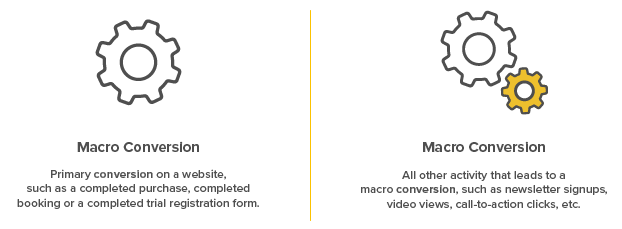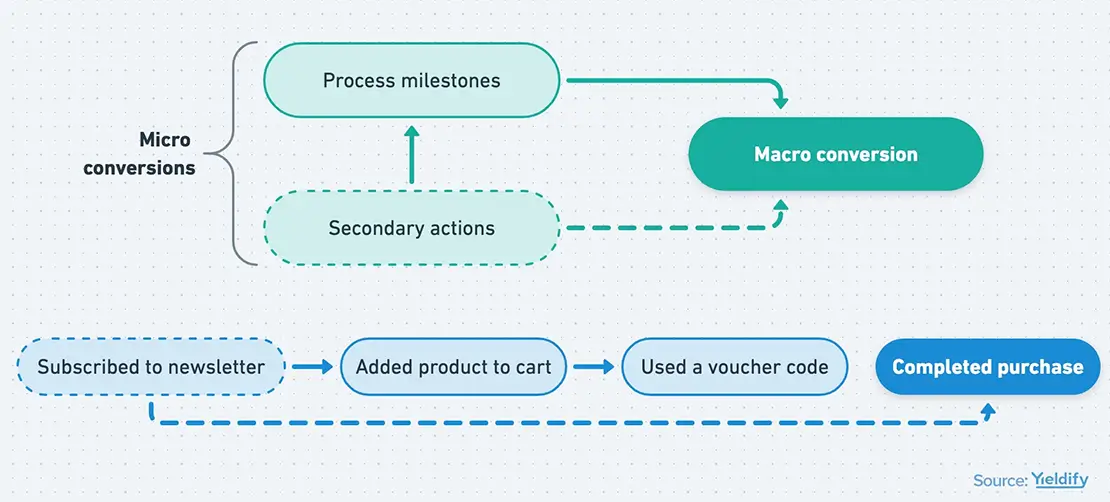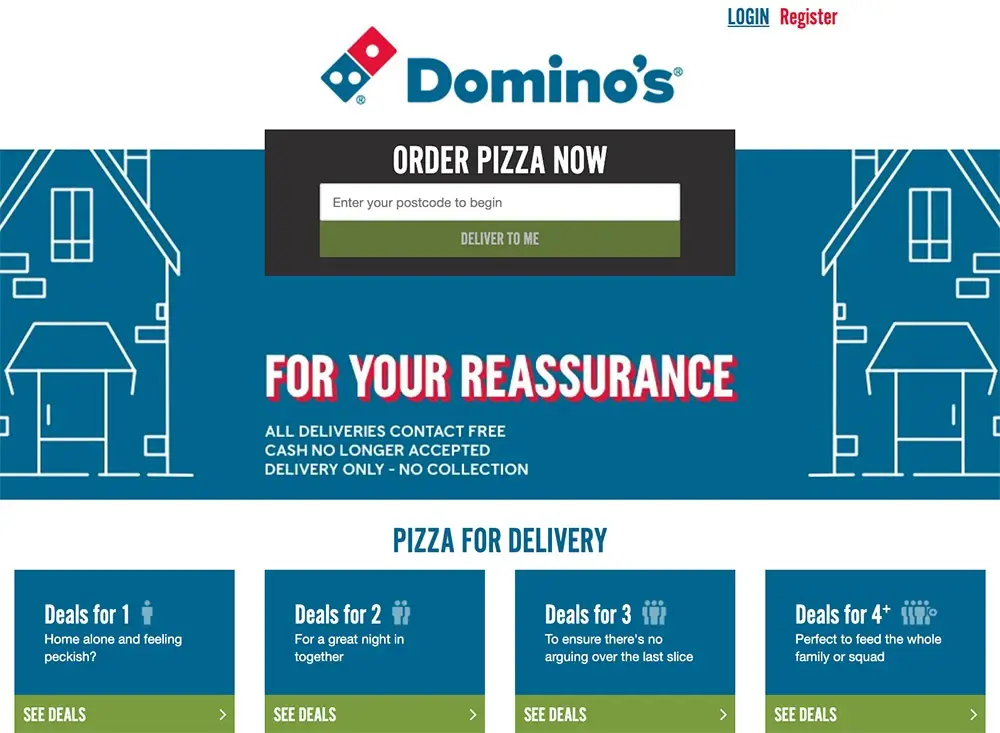BLOG
What Are Micro Conversions and How to Track Them
Published: Apr 23, 2020
Micro conversions are crucial for eCommerce sales, yet too many businesses still overlook them. Let’s explore what micro conversions are exactly and how to track them.
What do we talk about when we talk about eCommerce conversions? For many, it’s that transaction that marks the completion of a sale – in other words, the conversion of a visitor into a paying customer.
Arguably, this is the most important conversion as it is related directly to your revenue. However, it isn’t the only meaningful event happening on your site.
In fact, in order for a customer to reach the point where they can make a purchase, they are likely going to complete several micro conversions en route. In this article, we’re going to take a look at what micro conversions are, and why they matter.
In this article we will cover the following:
1. What is a micro conversion?
2. Why you should track micro conversions
3. Micro Conversion Examples in eCommerce
4. How you can track micro conversions in Google Analytics
5. Summary
What is a micro conversion?
Micro conversions vs. macro conversions
When it comes to explaining the difference, it’s easier if we start with determining what a macro conversion stands for in the eCommerce world.
A macro conversion is the actual purchase of a product or service itself. To get here, your customer has to engage with your website on multiple levels. In most cases, businesses will find it impossible to reach their macro conversion without their website visitors making at least a couple of micro conversions first.

A micro conversion is each and every active engagement with the website before the sale. There are lots of different micro conversions a customer might partake in, but they can be roughly divided into two types: process milestones and secondary actions.
Process milestones are micro conversions that take a visitor one step closer to completing a macro conversion. In other words, anything that directly leads towards the sale. This might include:
- Browsing through multiple pages of the website.
- Using the website’s search function.
- Adding products to their basket.
- Inputting voucher codes.
Secondary actions might not lead directly to a sale today, but are actions that might improve the chances of a visitor returning and making a purchase at another time. These could include:
- Signing up to a newsletter.
- Commenting on blog posts.
- Watching videos.
- Downloading ebooks.
- Creating an account with the website.
The below chart displays how secondary actions can directly influence process milestones, thus indirectly influencing macro conversions.

The best example of a micro conversion is an action that feels small and insignificant to the user, but ultimately makes a big impact on their likelihood to see a macro conversion through. Browsers often have auto-fill features that can make signing up to a new account on a website as easy as two clicks – but the lasting impact of that account is the potential for many macro conversions in the future.
Why should I track micro conversions?
Given that micro conversions make up such a large percentage of the activity on a website, they can provide a lot of insight into what you’re doing right – and what you’re doing wrong. Tracking micro conversions will allow you to finetune your website and help you to increase the rate of your macro conversions.
Tracking various process milestones will enable you to better understand your eCommerce website’s UX.
For example, you might see that customers are using your website’s search function multiple times in a visit, but you aren’t seeing many items being added to baskets by these same users. This could be a sign that your search isn’t finding the relevant results. Alternatively, it might simply alert you to a related product that you hadn’t previously thought of stocking.
Low-traffic websites are especially vulnerable to the effects of poor UX, and so micro conversion tracking can be particularly useful. When visitor numbers are low, it’s important to make the most of each and every person browsing your site – and analysis of micro conversion statistics might be the difference between a bad week and a great one.
Tracking secondary actions will allow you much greater insight into how well you’re engaging your website’s visitors.
If plenty of users are opening accounts with the website, but are opting out of newsletters, you might want to think about why your marketing isn’t connecting in the way you’d like. Tracking views and engagement with blog and video posts will allow you to quickly discover exactly which topics people are most interested in – and to stop wasting resources creating content that isn’t having the intended impact.
Micro-conversion examples in eCommerce
There are so many practical applications for micro conversions in eCommerce that it’s worth thinking about which ones are going to have the most impact for you, and how tracking them might provide useful insight for your business.
Let’s look at some examples!
The first page a visitor encounters on the website for pizza delivery service Domino’s is an input for the user’s postcode. On a practical level, this is an important micro conversion that starts each customer journey towards their purchase. By sharing their postcode, potential customers enable location-specific offers that will further tempt them to buy a pizza.
This micro conversion holds useful information for Domino’s, allowing the business to track interest in their products in different areas at different times of the week. The data garnered might help them to put better offers in place when necessary – or even convince them to open up a new store in areas of high demand.

Holiday camp travel company Homair offers two opposing micro conversion opportunities on their homepage – with opportunities for users to sign up to receive email newsletters vs. physical brochures.
This allows for easy A/B testing using the results of their micro conversion tracking, giving insight into the preferences of those using the website. If engagement is particularly high with the brochures, Homair can consider investing in more physical marketing campaigns that might better reach that audience.
Alternatively, a surge in sign-ups to the email newsletter might inform them that fewer physical copies might be needed for their next physical brochure. Tracking would also allow a company to test click-rates when the CTAs are placed in different areas of the website, and see which is most successful.

Online gambling sites often have several different micro conversion options across their homepages. Different visitors will be attracted by different offers, and it’s important to appeal to them all.
Betfair’s website features different incentives to encourage new users to sign-up. During football season, odds will be offered for specific matches and the data relating to each micro conversion allows the company to choose which events and offers to highlight the next week.
Similarly, long-standing offers like those shown above can be rotated based on performance or even shown only at the specific periods where they have been proven to encourage the most successful macro conversions.

How to track micro conversions in Google Analytics
Google Analytics is perhaps the best platform for easy micro conversion tracking. Its simple and free system encourages users to think about their conversion funnel, and how they might use micro goals to better direct their visitors towards a macro conversion.
What are micro goals? Micro goals are the individual stages that you want your users to take during their customer journey on your website. Each represents a micro conversion that is yet to happen – and your aim is to build a conversion funnel that will guide visitors towards each goal in turn.
Google Analytics allows users to set up to 20 Goals that can be tracked through their dashboard. Pre-set goals include all the most common micro conversions, like new account sign-ups, content downloads, and social media shares. Each Goal you set allows you to keep track of conversions based on the measurement of your choosing. You might want to check how many users have watched a specific video, or perhaps you’re more interested in how much time visitors are spending on certain pages.
With 20 Goals available to you, it’s possible to track micro conversions from the moment a visitor lands on your website right up until they make the macro conversion that everything is geared towards. Think about what your ideal conversion funnel is, and choose micro goals that best lead your user base in that direction.
Soon, you’ll be able to analyze exactly which micro conversions are seeing the most traffic, and which could use tweaking. You can opt to place CTAs in the areas receiving the most traffic, and think about how you might better direct people to pages that are under-served.
In conclusion
Micro conversions are hugely prolific in eCommerce, but many companies are completely overlooking their role in leading to that final macro conversion.
Take advantage of this: spend time thinking about your customer journey, and analyzing the role micro conversions have in bringing your visitors to their final purchase. You’ll open up all sorts of opportunities to help increase conversion rates, and give your customers an experience they’ll be keen to repeat.
A micro conversion can be defined as user completing a small step along their path towards completing a primary conversion goal (or macro conversion). For example, signing up for a newsletter (mirco) before purchasing (macro) from an eCommerce website.
Examples of micro conversions include:
1. Newsletter sign ups
2. Add to baskets
3. Using the site search function
3. Downloading eBooks or other gated content
4. Viewing a certain amount of pages